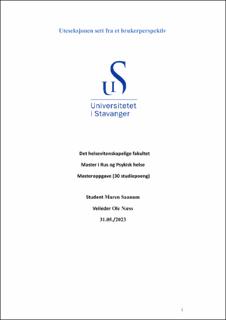| dc.contributor.advisor | Næss, Ole | |
| dc.contributor.author | Saanum, Maren | |
| dc.date.accessioned | 2023-09-05T15:51:23Z | |
| dc.date.available | 2023-09-05T15:51:23Z | |
| dc.date.issued | 2023 | |
| dc.identifier | no.uis:inspera:149179816:93476692 | |
| dc.identifier.uri | https://hdl.handle.net/11250/3087590 | |
| dc.description.abstract | Bakgrunn
Jeg har valgt å skrive om forebyggende arbeid blant ungdom fordi jeg syns dette er viktig og verdifullt arbeid. Etter min mening bør forebygging settes høyere på den helse- og sosialpolitiske dagsorden.
Hensikt og problemstilling
Det er en økning av ung uføre, økning av unge som debuterer med rusmidler og økning av straffbare forhold registret på ungdom under 18 år. Forebyggende arbeid blant unge er viktig slik at en eventuell negativ utvikling kan stanses tidlig. Forebyggende arbeid handler om å tilrettelegge for at alle skal ha like gode muligheter til å leve helsefremmende liv. Hensikten med studien er å undersøke hvordan ungdommene erfarer uteseksjonen gjennom et salutogent perspektiv. Ungdommene sine erfaringer er verdifull kunnskap da det kan brukes som læring i hjelpeapparatet. Studiens problemstilling er: Hvordan erfarer ungdommene uteseksjonen i Stavanger?
Forskningsspørsmålene er:
-Hvordan opplever ungdommene oppsøkende sosialt arbeid som en arbeidsmetode?
-På hvilke områder har uteseksjonen bidratt i ungdommenes liv?
Metode
Denne studien benytter kvalitativ metode. Jeg har gjennomført 6 en-til-en intervjuer med 4 jenter og 2 gutter i forskjellig alder. Analysemetoden jeg har benyttet er tematisk analyse med utgangspunkt i Braun og Clarke sin oppskrift.
Resultat og konklusjon
Studien indikerer at uteseksjonen i Stavanger er betydningsfull for ungdommene. Uteseksjonen har gitt ungdommen støtte, hjelp og omsorg når de har trengt det. De har stilt opp og vært med å tilrettelegge for å kunne håndtere vanskelige situasjoner i hverdagen. Dette indikerer at uteseksjonen i Stavanger er et tiltak som er og vil være helsefremmende for ungdommen. Funnene tyder på at den salutogene modellen egner seg godt til å bruke i undersøkelser når en skal se på erfaringene av et helsefremmende tiltak. Resultatene viste hvordan uteseksjonen har skapt en tett relasjon til ungdommen, og at de har klart å motivere til endring noe som kan være interessant for videre forskning. | |
| dc.description.abstract | Background
I have chosen to focus on preventive work aiming to reduce unsociable and self inflicted risk taking behaviour among young vulnerable people in a bigger Norwegian city because I think this is a very important and valuable type of work. In particular the work carried out by the Uteseksjonen is given a major attention herein.
The term “Uteseksjonen” may need some further explanation/elaboration here: A special ‘task force’ you might say and typically found in greater Norwegian cities or municipalities. The staff belonging to the Uteseksjonen is personnel employed by the municipality and consists of specially skilled social workers. Their working arena is out on the city streets searching for- and facing youths in- or potentially seeking unhealthy environments.
In my opinion, this sort of work deserves to be ranked higher on the health and social policy agenda.
Purpose and problem statement
In Norway there is an increase in the number of youth who receive disability benefits from NAV, debuting with drugs at an early age and an increase in criminal offenses registered among young people under the age of 18. Preventive work among young people is important in order to stop any negative development at an early stage. Preventive work out there on the streets among vulnerable young people is also about providing equal opportunities for these youngsters by promoting a healthy lifestyles. The purpose of this study us to investigate how young people in Stavanger experience the work carried out by the social workers in the street based Uteseksjonen through a salutogenic perspective. The young people’s experience with the approach of the Uteseksjonen team in the streets is very useful and valuable knowledge as it can be recorded and used as a‘lesson learned’ material by the Uteseksjonen team for future works.
The challenges involved with these issues are expressed by the following statement: How do young people experience Uteseksjonen in Stavanger?
Questions raised here which may be an object of further research are:
- How do young people experience outreached social work as a work method?
- In which areas have the Uteseksjonen contributed to the young people’s lives?
Method
This study uses a qualitative method. I have conducted 6 one-to-one interviews with 4 girls and 2 boys of different ages. The analysis method I have used is a thematic analysis based on Braun and Clarke's recipe.
Results and conclusion
This study clearly indicates that the Uteseksjonen plays a significant role for young in the city of Stavanger. The Uteseksjonen give the young people support, help and care when they have needed it. They have stood up for them and helped them to organize their lives and thereby enabled them to handle difficult situations which they may encounter in their everyday life. This clearly shows that the Uteseksjonen in Stavanger is successful initiative that will improve the wellbeing and health-conditions for city youths. The findings suggest that the salutogenic model is well suited for use in research when considering the experiences and track record of the Uteseksjonen in a health promotion initiative perspective. The results show how Uteseksjonen has been able to create a close relationship with the young people in the city, and that they have managed to motivate many of them to a change lifestyle and attitude. This is something that could be interesting to pursue for further research purposes. | |
| dc.language | nob | |
| dc.publisher | uis | |
| dc.title | Uteseksjonen sett fra et brukerperspektiv | |
| dc.type | Master thesis | |
